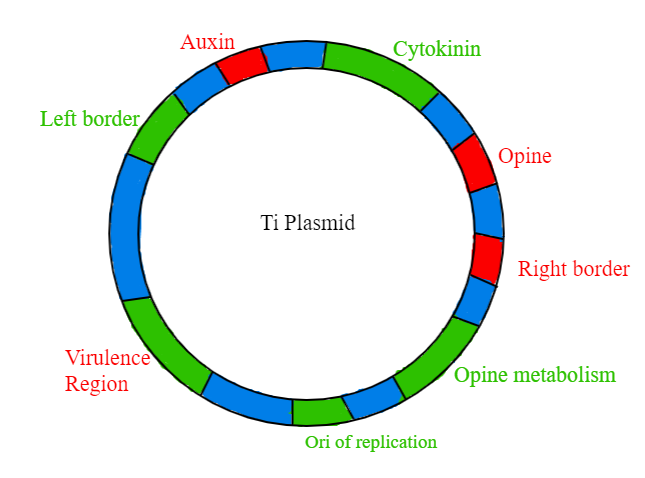Answer
397.2k+ views
Hint: Ti plasmid is a member of a community of plasmids from several types of Alphaproteobacteria. Representatives of this plasmid family are defined by the presence of a preserved DNA region known as the repABC gene cassette, which facilitates the proliferation of the plasmid, the differentiation of the plasmid into the daughter cells during cell division, and also the preservation of the plasmid at small copy numbers in the cell.
Complete answer: Agrobacterium is a phytopathogenic type of bacteria able to pass fragments of its genome to plant cells. Tumour inducing (Ti) is a plasmid identified in Agrobacterium species. The portion, called "T-DNA," is situated on a large plasmid (Ti plasmid) in the microorganism. Upon transfer to the plant, T-DNA is firmly incorporated into the genome of the plant and therefore genetically converts its target cell. T-DNA could be designed to hold virtually any sequence without compromising the potential of the bacteria to manipulate its host. As a consequence, Agrobacterium was embraced as the chosen mode for the development of transgenic plants with unique traits of agronomic and scientific significance.

Hence, the correct option is (B).
Note: Agrobacterium tumefaciens is a gram-negative bacteria capable of infecting crops by delivering a specific segment of its genome to the nucleus of resistant plant cells. Greater knowledge of this mechanism will encourage the creation of better equipment for the production of genetically modified plants and thereby enhance our understanding of core cell functions and host-pathogen associations.
Complete answer: Agrobacterium is a phytopathogenic type of bacteria able to pass fragments of its genome to plant cells. Tumour inducing (Ti) is a plasmid identified in Agrobacterium species. The portion, called "T-DNA," is situated on a large plasmid (Ti plasmid) in the microorganism. Upon transfer to the plant, T-DNA is firmly incorporated into the genome of the plant and therefore genetically converts its target cell. T-DNA could be designed to hold virtually any sequence without compromising the potential of the bacteria to manipulate its host. As a consequence, Agrobacterium was embraced as the chosen mode for the development of transgenic plants with unique traits of agronomic and scientific significance.

Hence, the correct option is (B).
Note: Agrobacterium tumefaciens is a gram-negative bacteria capable of infecting crops by delivering a specific segment of its genome to the nucleus of resistant plant cells. Greater knowledge of this mechanism will encourage the creation of better equipment for the production of genetically modified plants and thereby enhance our understanding of core cell functions and host-pathogen associations.
Recently Updated Pages
How many sigma and pi bonds are present in HCequiv class 11 chemistry CBSE

Why Are Noble Gases NonReactive class 11 chemistry CBSE

Let X and Y be the sets of all positive divisors of class 11 maths CBSE

Let x and y be 2 real numbers which satisfy the equations class 11 maths CBSE

Let x 4log 2sqrt 9k 1 + 7 and y dfrac132log 2sqrt5 class 11 maths CBSE

Let x22ax+b20 and x22bx+a20 be two equations Then the class 11 maths CBSE

Trending doubts
Fill the blanks with the suitable prepositions 1 The class 9 english CBSE

At which age domestication of animals started A Neolithic class 11 social science CBSE

Which are the Top 10 Largest Countries of the World?

Give 10 examples for herbs , shrubs , climbers , creepers

Difference between Prokaryotic cell and Eukaryotic class 11 biology CBSE

Difference Between Plant Cell and Animal Cell

Write a letter to the principal requesting him to grant class 10 english CBSE

Change the following sentences into negative and interrogative class 10 english CBSE

Fill in the blanks A 1 lakh ten thousand B 1 million class 9 maths CBSE



